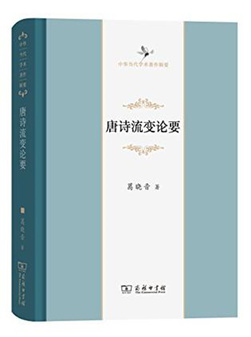Discover the beauty of ancient poetry
Author : LI PENGFEI Source : Chinese Social Sciences Today 2018-01-09

Briefs on the Changes of Tang Poetry
Author: Ge Xiaoyin
Publisher: Commercial Press
Various forms of ancient Chinese poetry emerged in the pre-Qin period through to the Han and Wei dynasties. Numerous poetry theories that were formed in ancient times looked at the relationship between various poetic forms and artistic performance. However, most of this ancient commentary was impressionistic, and most of the research today concentrates on formal principles, lacking insight into how these principles are formed. Also, even in an age relatively unburdened by ideological influence, people are still more likely to focus on the content of literary and artistic works, while ignoring form. This is because content is explicit and easier to notice, and form tends to melt into the content, which is implicit, and thus less noticeable. In addition, the study of content is relatively easy, while research into form is much more difficult.
Before Ge Xiaoyin, although there was plenty of research on the artistic forms of poetry, only Lin Geng and Komatsu Matsuura conducted in-depth discussions on how the formal principles of ancient Chinese poetry were created. At the beginning of the 21st century, Ge, having been influenced by the two previous scholars, began her research on poetic styles from the pre-Qin to Sui and Tang dynasties. Starting with the source of poetry, Ge illustrated the generation, evolution, and creation principles of various poetic styles from the aspects of linguistic changes, rhythm, verse, structure and performance, to explain how the various artistic principles and creation traditions recorded in ancient archives were formed.
As for Ge’s studies on poetic styles, I suspect that some readers may feel that such a thorough study on format will be boring, and even doubt the necessity of doing so. In fact, ancient Chinese poetry was very much concerned about these specific issues of form and rhythm, because these issues directly related to the creation of poetry. Since the content of poetry depends on poets and the times, many principles concerning rhythm and form are beyond space and time, and thus can be used and developed by poets of different ages.
In Ge’s research the mysteries of writing ancient Chinese poetry have been systematically revealed. The mystery of the beauty of ancient poetry has been effectively elucidated from the aspects of form and rhythm. For example, why was poetry of the Wei and Jin dynasties regarded as like nature itself – the highest quality of art? Why did the Tang Dynasty quatrains become the peak of this form? These questions are given clear explanations from the principles of form and expression.
More importantly, for the first time, Ge’s study of style enables us to understand the immense importance of the artistic forms of poetry, so that we can clearly see how the ancient poets persevered in the pursuit of formal innovation and stylistic freedom, and eventually created the beauty of poetry due to the freedom of form. It is fair to say that many of the theoretical insights that Ge put forward from her in-depth study of specific poetry issues accord with the basic principles of the philosophy of art.
Ye Shengtao made Chinese fairy tales from a wilderness
Ye Shengtao (1894–1988) created the first collection of fairy tales in the history of Chinese children’s literature...
-
How northern ethnicities integrated into Chinese nation
2023-09-18
-
Mogao caves
2023-09-12
-
Mogao Grottoes as ‘a place of pilgrimage’
2023-09-12
-
Time-honored architectural traditions in China
2023-08-29
-
Disentangling the civilizational evolution of China
2023-08-28
-
AI ethics in science fiction
2023-08-23














 2011-2013 by www.cssn.cn. All Rights Reserved
2011-2013 by www.cssn.cn. All Rights Reserved